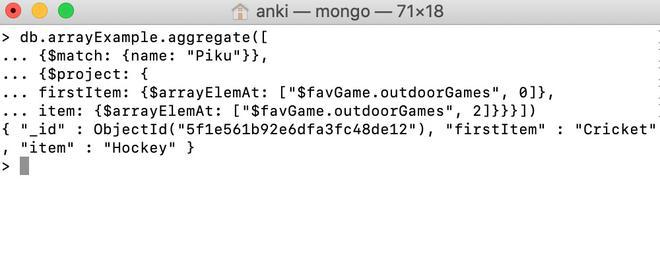MongoDB $arrayElemAt Operator (original) (raw)
Last Updated : 07 Mar, 2025
MongoDB is a widely used NoSQL database known for its flexible data model. One of the essential features of MongoDB is its support for array data types. The $arrayElemAt operator is a key part of MongoDB's **aggregation framework, enabling developers to retrieve specific elements from arrays. Whether we need to access the first, last, or an arbitrary element, $arrayElemAt provides an efficient way to manipulate array data in MongoDB.
What is the MongoDB $arrayElemAt Operator?
The $arrayElemAt operator allows us to retrieve an element from an array at a specified index. It is often used within the **aggregation pipeline to transform and manipulate data efficiently. The operator is particularly useful when we need to work with large datasets containing arrays and need to extract a specific value without looping over the entire array.
**Syntax:
{ $arrayElemAt: [ , ] }
**Key Terms
<array>: An array or an expression that resolves to an array.<index>: The index of the element to retrieve. It can be a positive or negative integer.
Key Features
- **Positive Index: If the index is positive,
$arrayElemAtwill retrieve the element starting from the beginning of the array. - **Negative Index: If the index is negative,
$arrayElemAtcounts backward from the end of the array. - **Out-of-Bounds Index: If the index exceeds the array bounds, the operator will return
null
Use Cases for MongoDB $arrayElemAt
The $arrayElemAt operator can be applied in various scenarios, especially when we need to retrieve specific data from arrays. Below are some common use cases:
1. **Retrieve the First or Last Element of an Array
We can easily fetch the first or last item from an array by specifying index 0 or -1, respectively.
2. **Access Array Elements at Specific Indices
When working with large arrays, we may only need to retrieve an element from a particular position. The $arrayElemAt operator makes this possible.
3. **Handle Arrays in Embedded Documents
MongoDB allows arrays within embedded documents. The $arrayElemAt operator can be used to retrieve elements from arrays within these embedded structures.
**Examples of MongoDB $arrayElemAt
To understand the **MongoDB $arrayElemAt we will consider below collection called **arrayExample and performs various queries on it for better understanding.

**Example 1: Retrieving First and Last Items
In this example, we are going to find the elements of the array(i.e., the value of fruits field) on the specified index using $arrayElemAt operator.
**Query:
db.arrayExample.aggregate([
{ $match: { name: "Bongo" } },
{ $project: {
firstItem: { arrayElemAt:["arrayElemAt: ["arrayElemAt:["fruits", 0] },
lastItem: { arrayElemAt:["arrayElemAt: ["arrayElemAt:["fruits", -1] }
}
}
])
**Output:

Explanation:
- The
$arrayElemAtoperator is used to extract the first and last elements of thefruitsarray. - The element at index
0is"Apple", and the element at index-1(last element) is"Orange".
**Example 2: Using $arrayElemAt Operator in the Embedded Document
In this example, we are going to find the elements from the outdoorGames array, which is inside the embedded document favGame, for a document with name: "Piku" using $arrayElemAt operator.
**Query:
db.arrayExample.aggregate([
... {$match: {name: "Piku"}},
... {$project: {
... firstItem: {$arrayElemAt: ["$favGame.outdoorGames", 0]},
... item: {$arrayElemAt: ["$favGame.outdoorGames", 2]}}}])
**Output:

Explanation:
Here, $arrayElemAt is used to extract the first item ("Football") and the third item (index 2, "Cricket") from the outdoorGames array inside the favGame embedded document.
Best Practices for Using MongoDB $arrayElemAt
When working with the $arrayElemAt operator, it's important to follow best practices to ensure efficiency and correctness:
1. **Ensure Valid Index Values
- Always verify that the index is valid. If the index exceeds the array length, MongoDB will return
null. - Use the
$sizeoperator to dynamically calculate the array length if needed.
2. **Use $arrayElemAt in the Aggregation Pipeline
The operator is most commonly used in the aggregation pipeline stages like $project, $addFields, or $group to transform data.
3. **Combine with Other Operators
Combine $arrayElemAt with other aggregation operators like $ifNull, $cond, and $size to handle edge cases such as missing or empty arrays.
4. **Optimize Performance
Although $arrayElemAt is efficient, use it carefully in complex queries to avoid performance degradation, especially with large datasets. Ensure that your queries are optimized and that unnecessary use of the operator does not hinder query performance.
**Conclusion
The $arrayElemAt operator in MongoDB's aggregation framework is a handy tool for accessing elements within arrays in your documents. Whether we need to retrieve the first, last, or any other element at a specific index, this operator provides a flexible and efficient way to work with array data. By understanding its syntax and common use cases, we can easily incorporate this operator into our MongoDB queries and aggregations to manipulate array data with precision.